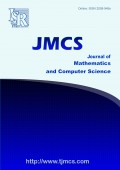Designing an Intelligent System for Diagnosing Diabetes with the Help of the Xcsla System
-
2217
Downloads
-
3893
Views
Authors
Ehsan Sadeghipour
- Sama technical and vocational training college, Islamic Azad University, Bandar Abbas Branch, Bandar Abbas, Iran,
Ahmad Hatam
- University of Hormozgan, Faculty of Power and Computer Engineering, University Hormozgan, Bandar Abbas, Iran,
Farzad Hosseinzadeh
- Sama technical and vocational training college, Islamic Azad University, Bandar Abbas Branch, Bandar Abbas, Iran,
Abstract
An intelligent method for diagnosing diabetes is introduced in this article. One of the main problems involved in this disease is that it is not diagnosed correctly and in time and, due to the destructive effects of the progression of the disease on the human body, the need for its timely prediction and diagnosis is felt more than ever before. At present, doctors diagnose diabetes based on documents, scientific tests, and their own experience. However, considering the huge number of patients, a decision support system for recognizing the disease pattern in diabetics can be used. Results of Program Implementation Document (PID) on databases indicated the higher efficiency of the proposed method in diagnosing diabetes compared to the classic XCS system, the ELMAN neural network, SVM clustering, KNN, C4.5, and AD Tree.
Share and Cite
ISRP Style
Ehsan Sadeghipour, Ahmad Hatam, Farzad Hosseinzadeh, Designing an Intelligent System for Diagnosing Diabetes with the Help of the Xcsla System, Journal of Mathematics and Computer Science, 14 (2015), no. 1, 24-32
AMA Style
Sadeghipour Ehsan, Hatam Ahmad, Hosseinzadeh Farzad, Designing an Intelligent System for Diagnosing Diabetes with the Help of the Xcsla System. J Math Comput SCI-JM. (2015); 14(1):24-32
Chicago/Turabian Style
Sadeghipour, Ehsan, Hatam, Ahmad, Hosseinzadeh, Farzad. "Designing an Intelligent System for Diagnosing Diabetes with the Help of the Xcsla System." Journal of Mathematics and Computer Science, 14, no. 1 (2015): 24-32
Keywords
- Decision support system
- blood sugar
- processing
- intelligent system
- artificial intelligence
MSC
References
-
[1]
, Report of WHO: Prevention and control of diabetes mellitus, , (1993), 3-8
-
[2]
Seyyed Ehsan Tahami, S. M. Bamshaki, M. A. Khalilzadeh, Diagnosing Diabetes Type I by using the ANFIS, GA-NN algorithm, The First Joint Conference of Intelligent Systems and Fuzzy Systems, Ferdowsi University of Mashhad (2007)
-
[3]
, Iran Diabets Society , http://www.ir-diabetes-society.com / Avarez %20diabet.htm , ()
-
[4]
L. I. Kuncheva, J. C. Bezdek, R. P. W. Duin, Decisiontemplates for multiple classifier fusion: an experimental comparison, Pattern Recognition, 34(2) (2001), 299–314.
-
[5]
Bi. Yaxin, David Bell , Hui Wang, Gongde Guo, Jiwen Guan, Combining Multiple Classifiers Using Dempster’s rule for text Caregorization, Applied Artificial Intelligence, 21:3 (2007), 211- 239.
-
[6]
S. Tulyakov, S. Jaeger, V. Govindaraju, D. Doermann, Review of Classifier combination Methods, Studies in Computational Inteligence(SCI), 90 (2008), 361-386.
-
[7]
M. Sugeno, Industrial Applications of Fuzzy Control, Elsevier, Book , New York (1985)
-
[8]
F. Bergh, A. Engelbrecht, A new locally convergent particle swarm optimizer, IEEE, Fundamenta Informatic Journal , (2002)
-
[9]
L. I. Kuncheva, Combining Pattern Classifiers, Methods and Algorithms, NY: Wiley Interscience, New York (2005)
-
[10]
J. Kittler, M. Hatef, R. Duin P. W., J. Matas, On Combining Classifiers, IEEE Transactions on Pattern Analysis and Machine Intel ligence, 20(3) (1998), 226–239.
-
[11]
M. Shanker, Using neural networks to predict the onset of diabetes mellitus, J Chem Inform Computer Science, 36 (1996), 35–41.
-
[12]
D. Dazzi, F. Taddei, A. Gavarini, E. Uggeri, R. Negro, A. Pezzarossa, The control of blood glucose in the critical diabetic patient: a neuro-fuzzy method, Journal of Diabetes Complications, 15(2) (2001), 80–87.
-
[13]
Y. Jiang, Z. Zhou, Editing Training Data for kNN Classifiers with Neural Network Ensemble, in Proc. ISNN (1), (2004), 3956-361.
-
[14]
Javad Haddadnia, J. Vahidi, A. Gharah-khani, V. M. Fayyouzi, Fuzzy diagnosis of Diabetes Based on Rules and Optimal Characteristics Based on a Combination of data mining Systems and Artificial Intelligent Algorithms ICNMO, , (2012)
-
[15]
Mohammadreza Keyvanpour, L. Khalatbari, Comparison of Classifier Algorithms in Diagnosing Diabetes and heart Failure, , ()
-
[16]
I. H. Witten, E. Frank, Data Mining (Practical Machine Learning Tools and Techniques), nded, San Francisco: Morgan, Kaufmann (2005)
-
[17]
M. Shariat Panahi, N. Moshtaghi Yazdani, An Improved XCSR Classifier System for Data Mining with Limited Training Samples, Global Journal of Science, Engineering and Technology, (ISSN: 2322-2441), Issue 2 (2012), 52-57.
-
[18]
Navid Moshtaghi Yazdani, A. Yazdani, Improving the XCS algorithm by Using Learning Automata, The International Computer, Information Technology and Digital Media Conference, (2013)
-
[19]
C. L. Blake, C. J. Merz , UCI Repository of Machine Learning Databases, http://www.ics.uci.edu/mlearn/MLRepository.html., (1998)

